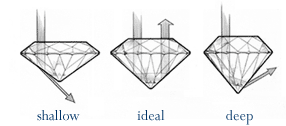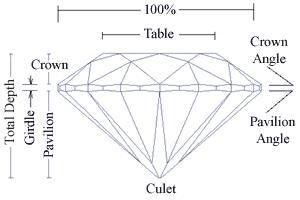

![]()
When purchasing a diamond there are several factors that one should take into account. Each factor will aid in ensuring that your diamond purchase best suits the person and the occasion. Among the most important factors are the 4 C's. The 4 C's refer to the color, clarity, carat weight, and cut of a diamond. A diamond's quality is mainly determined by these characteristics.
To obtain reliable details about a diamond one should review a certification by a reputable certifying organization such as GIA or AGS. Of the 4C's, cut is the most significant in determining the appearance of a diamond.
Diamond Color
Diamonds naturally occur in a number of different colors. Most diamonds range from colorless to a light yellow or brownish color. Colorless is considered to be the highest quality. Color is rated on a scale that ranges from D (colorless) to Z(light obvious color). There are subtle differences between the grades, the difference between a D color diamond and an I color diamond can be hard to tell when viewed separately and the deference between a D and F diamond may be hard to see when viewed side by side. Diamonds that naturally occur with a vibrant shade of some rarer colors are referred to as fancy. Fancy colored diamonds are judged on a different color scale. An intensely colored fancy diamond may have a high value, whereas a non-fancy diamond will have its highest value at the colorless end. Any diamond rated on the D to Z color scale is not a fancy diamond.

Diamond Clarity
Clarity is a measure of the purity or cleanness of a diamond. A diamond is clean if it has no internal inclusions or external blemishes. An inclusion is a natural impurity within the diamond whereas a blemish is on the surface, such as a scratch. Clarity is graded upon a scale ranging from flawless to imperfect. The grading scale rates the visibility of the inclusions of a stone.

Carat Weight
A carat is a measure of weight corresponding to 0.2 grams. For some this may be confusing since the size of a diamond is often referred to by carat. Due to the various ways diamonds are cut, a diamond that appears large to the naked eye, or from a particular angle may in fact be of a lower weight than one expected. Although weight and size are related to each other, the proportions of the diamond will affect the apparent size to a certain degree. When comparing diamonds it is essential to know the carat weight since the naked eye may be fooled.

Diamond Cut
The cut determines how sparkly your diamond will be. A properly cut diamond will refract the light that enters the diamond and return it through the top to produce the sparkle that is so desired.

The typical brilliant
cut diamond is cut with 58 facets, 33 on the crown and 25 on the pavilion.
On a well-proportioned stone, these facets will be uniform and symmetrical.
If they are not, the diamond's ability to refract and reflect light will
suffer.
The two most
important numbers to be looking for when looking for great cut are the
depth percentage and the table percentage.

Depth percentage is the depth of the diamond (table to culet) divided by the width of the diamond. The higher the number, the deeper the stone. The lower the number the shallower the stone. For example, a diamond with depth of 4.09 mm and width of 6.75 mm equals a depth percentage of 60.6%. For a round diamond, the depth percentage for the ideal cut class is 58-62.9%.
Table percentage is the length of the table divided by the width of the diamond. The higher the number, the bigger the table looks. The lower the number, the smaller the table looks. For example, a diamond with table of 3.91 mm and width of 6.75 mm equals a table percentage of 57%. For a round diamond, the table percentage for the ideal cut class is 53-57%. Do not confuse small table with small diameter. In general, you want the bigger diameter and the smaller table percentage for the most beautiful round diamond.
Out of Round: It is interesting to note that "round" diamonds are usually not perfect circles. The length and width measurements for a round are both diameter measurements and will be different for an out-of-round shape. If the length is greater than the width by more than .10 millimeters, the diamond has not been cut well and should be avoided. For two-carat stones, the acceptable deviation is 0.12 millimeters.
What Is Ideal Cut? There is no industry
agreement on what constitutes an ideal cut round brilliant cut diamond.
Every grading laboratory has a different definition for it's top cut grades.
There is on going research by various organizations, including the GIA, to
determine which specifications produce the best brilliance, dispersion, and
scintillation
|
|
|